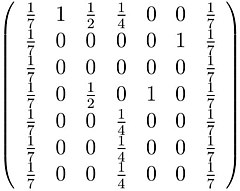Cheirank
The CheiRank is an eigenvector with a maximal real eigenvalue of the Google matrix G ∗ } constructed for a directed network with the inverted directions of links.
This article has multiple issues. Please help improve it or discuss these issues on the talk page. (Learn how and when to remove these template messages)
|
It is similar to the PageRank vector, which ranks the network nodes in average proportionally to a number of incoming links being the maximal eigenvector of the Google matrix with a given initial direction of links. Due to inversion of link directions the CheiRank ranks the network nodes in average proportionally to a number of outgoing links. Since each node belongs both to CheiRank and PageRank vectors the ranking of information flow on a directed network becomes two-dimensional.

Definition

 and CheiRank probability
and CheiRank probability  for Linux version 2.6.32 with matrix size
for Linux version 2.6.32 with matrix size  at
at  , color shows the density of nodes with white for maximum and blue for minimum, black space has no nodes (from Chepelianskii)
, color shows the density of nodes with white for maximum and blue for minimum, black space has no nodes (from Chepelianskii)For a given directed network the Google matrix is constructed in the way described in the article Google matrix. The PageRank vector is the eigenvector with the maximal real eigenvalue 




















 (red curve) and CheiRank
(red curve) and CheiRank  (blue curve) on the corresponding rank indexes
(blue curve) on the corresponding rank indexes  and
and  . The straight dashed lines show the power law dependence with the slope
. The straight dashed lines show the power law dependence with the slope  respectively, corresponding to
respectively, corresponding to  (from Zhirov)
(from Zhirov)Examples
An example of nodes distribution in the plane of PageRank and CheiRank is shown in Fig.1 for the procedure call network of Linux Kernel software.

 shown by color with blue for minimum and white for maximum (black for zero); green/red points show top 100 personalities from PageRank/CheiRank, yellow pluses show top 100 personalities from Hart's book, number of articles
shown by color with blue for minimum and white for maximum (black for zero); green/red points show top 100 personalities from PageRank/CheiRank, yellow pluses show top 100 personalities from Hart's book, number of articles  (from Zhirov)
(from Zhirov)The dependence of 

The 2D ranking highlights the properties of Wikipedia articles in a new rich and fruitful manner. According to the PageRank the top 100 personalities described in Wikipedia articles have in 5 main category activities: 58 (politics), 10 (religion),17 (arts), 15 (science), 0 (sport) and thus the importance of politicians is strongly overestimated. The CheiRank gives respectively 15, 1, 52, 16, 16 while for 2DRank one finds 24, 5, 62, 7, 2. Such type of 2D ranking can find useful applications for various complex directed networks including the WWW.
CheiRank and PageRank naturally appear for the world trade network, or international trade, where they and linked with export and import flows for a given country respectively.
Possibilities of development of two-dimensional search engines based on PageRank and CheiRank are considered. Directed networks can be characterized by the correlator between PageRank and CheiRank vectors: in certain networks this correlator is close to zero (e.g. Linux Kernel network) while other networks have large correlator values (e.g. Wikipedia or university networks).
Simple network example





A simple example of the construction of the Google matrices 










See also
References
External links
This article uses material from the Wikipedia English article CheiRank, which is released under the Creative Commons Attribution-ShareAlike 3.0 license ("CC BY-SA 3.0"); additional terms may apply (view authors). Content is available under CC BY-SA 4.0 unless otherwise noted. Images, videos and audio are available under their respective licenses.
®Wikipedia is a registered trademark of the Wiki Foundation, Inc. Wiki English (DUHOCTRUNGQUOC.VN) is an independent company and has no affiliation with Wiki Foundation.